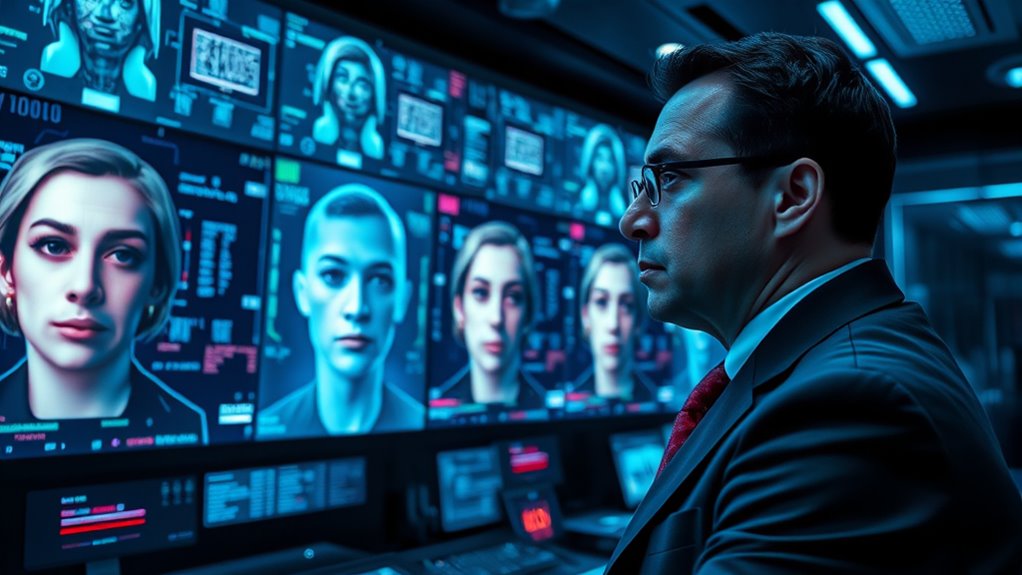Deepfakes, created with AI, can seriously threaten your national security by spreading misinformation, inciting violence, or manipulating political opinions. These realistic fakes blur the line between truth and deception, making detection challenging. Governments and organizations are working to develop detection tools and international strategies, but the risks grow as creators become more sophisticated. If you want to understand how these AI-generated fakes impact security and what can be done, you’ll find the details worth exploring further.
Key Takeaways
- Deepfakes can undermine national security by spreading misinformation and manipulating public opinion or government decision-making.
- Detection methods include analyzing facial movements, audio-visual sync, and employing machine learning to identify artifacts.
- Legal and ethical challenges hinder accountability and regulation of malicious AI-generated content across borders.
- International cooperation is essential to establish standards, enforce platform accountability, and combat transnational deepfake threats.
- Advancing AI security and cultural intelligence helps develop safeguards against increasingly sophisticated deepfake technologies.

Deepfakes, synthetic media created with artificial intelligence, pose a growing threat to national security by blurring the line between reality and deception. As these highly realistic videos, audio clips, and images become more sophisticated, they can be used to spread misinformation, manipulate public opinion, or even incite violence. Recognizing the potential danger, governments and security agencies are actively exploring detection techniques to identify deepfakes quickly and accurately. These methods include analyzing inconsistencies in facial movements, scrutinizing audio-visual synchronization, and leveraging machine learning algorithms trained to spot subtle artifacts that typical viewers might miss. Additionally, the ongoing development of cybersecurity tools and protocols is vital to counteract these threats effectively. However, as detection techniques improve, so do the methods for creating more convincing deepfakes, making it a continuous arms race between creators and investigators. AI security research continues to develop more advanced safeguards to counteract these threats, emphasizing the importance of cultivating a Cultural Intelligence approach to understanding and addressing emerging technological risks. Developing comprehensive public awareness campaigns can also help users recognize and report suspicious content, further strengthening defenses against deception. Furthermore, understanding the beneficial uses of AI can help promote responsible development and application of this technology to mitigate misuse. Alongside technical challenges, legal issues present significant hurdles. The legal landscape struggles to keep pace with the rapid evolution of AI-generated content. Determining accountability becomes complicated when deepfakes are used for malicious purposes, such as blackmail, political disinformation, or defamation. Laws often lag behind technological advancements, leaving authorities with limited tools to prosecute offenders or impose penalties effectively. Additionally, freedom of expression rights sometimes clash with efforts to regulate or ban deepfake content, raising concerns about censorship and privacy violations. Crafting legislation that balances security needs with civil liberties is a complex task, especially when the origins of a deepfake can be difficult to trace. The transnational nature of these threats further complicates enforcement, requiring international cooperation and standards. The international aspect of cyber threats complicates legal enforcement. An AI-generated fake created in one country can quickly spread globally, making jurisdiction and enforcement problematic. This transnational aspect demands coordinated efforts among nations to establish standards and frameworks for handling deepfakes. Without clear legal guidelines, there’s a risk that malicious actors exploit legal loopholes, further undermining security efforts. Governments are also exploring ways to hold platforms accountable for hosting or failing to remove harmful deepfake content, but defining responsibilities remains contentious. Strengthening international cooperation is essential to develop effective strategies and ensure consistent enforcement across borders.
Frequently Asked Questions
How Do Deepfakes Impact Diplomatic Relations Between Countries?
You might not realize it, but deepfakes critically impact diplomatic relations by fueling propaganda campaigns and complicating trust between nations. They can be used for diplomatic espionage, spreading false information, and undermining leaders’ credibility. As a result, countries may become more suspicious, leading to strained alliances and increased tensions. Recognizing these risks helps you understand why safeguarding against deepfake manipulation is essential for maintaining international stability.
What Legal Measures Exist Against Malicious Use of Deepfakes?
Legal measures against malicious deepfakes are like fences around a garden, protecting truth from deception. You’ll find laws that criminalize the creation and distribution of harmful AI-generated content, along with policy responses like content moderation and platform accountability. Many countries are updating legal frameworks to catch up with technology, aiming to deter malicious use and preserve trust. Staying informed about these laws helps you recognize and combat fake content effectively.
Can Deepfakes Be Used to Manipulate Financial Markets?
You might wonder if deepfakes can manipulate financial markets. They definitely can be used for financial fraud or stock manipulation by spreading false information about companies or market conditions. This can cause rapid price swings, misleading investors and damaging trust. As a result, it’s vital to develop detection tools and legal safeguards to prevent malicious actors from exploiting deepfakes for financial gain or market destabilization.
How Do Governments Detect and Counter Deepfake Threats?
You can help governments detect and counter deepfake threats by understanding their strategies. They use biometric analysis to identify subtle facial or voice inconsistencies, and digital watermarking to verify authentic content. By combining these methods, authorities can spot manipulated media more effectively. Staying informed about advances in AI detection techniques allows you to recognize potential deepfakes, supporting broader efforts to protect national security from AI-generated misinformation.
What Are the Ethical Considerations in Developing Deepfake Detection Technology?
Imagine building a security system where you don’t fully understand how it works—that’s the challenge with developing deepfake detection tech. You must balance privacy concerns and technological transparency, ensuring users’ rights are protected while fighting misinformation. Ethically, you need to avoid infringing on privacy or creating biases. Transparency builds trust and helps improve tools. You’re responsible for making sure these technologies serve the public good without compromising individual rights.
Conclusion
So, now you’re armed with the secret sauce of AI-fakes—ready to spot a fake from a mile away or even craft your own. Just remember, in a world where anyone can fake a president’s speech or forge a news anchor’s smile, staying vigilant isn’t just smart—it’s essential. After all, in the game of truth versus illusion, today’s deepfake might just be tomorrow’s headline. Keep your eyes open; the future’s faker than ever.









